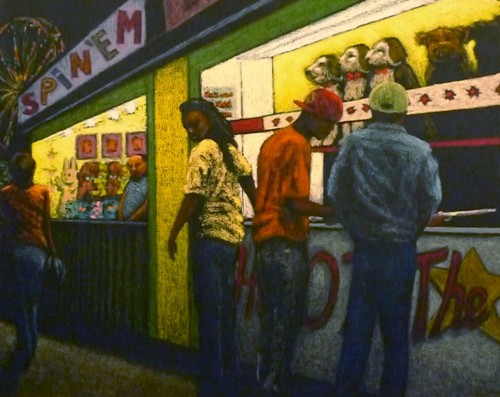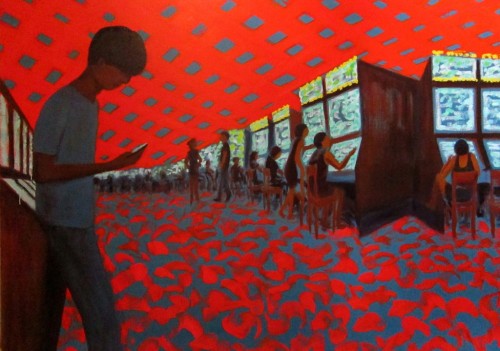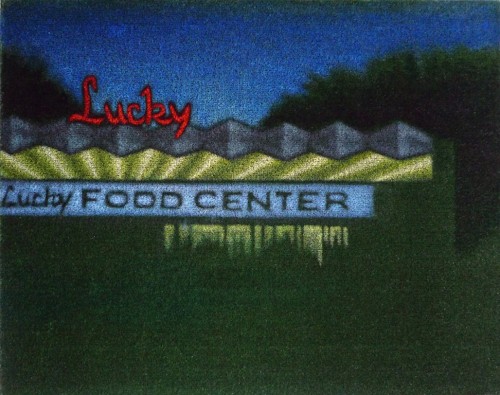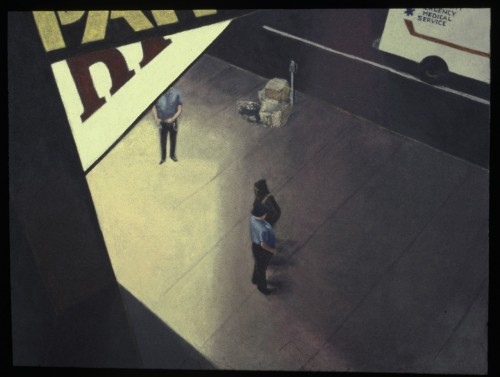STRIPPERS, SLOT MACHINES and strip malls, demo derbies and fun fairs all populate the garish neon world Jane Dickson paints. “I am interested,” she said back in the early 1990s, “in the ominous underside of contemporary culture that lurks as an ever-present possibility in our lives.” She still, I think, lived on Times Square then. She was a watcher, kind of like a latter-day Baudelaire, taking in the world, and her world was life on 42nd Street in all its humanity. This was where she had her two children, this at a time when those blocks were hardly a Disney world, but still a temple to the vices. As Don Winslow observed the crack vials crackled like shells underfoot, and sex could be had in many and any permutations. And, Jane painted them. She painted me even gracing the surface of red carpet off-cuts. The results were shown at the Whitney’s Philip Morris branch and toured across the country.
She has also painted the suburbs and fun fairs and San Gennaro Festival capturing moments of leering longing that particularly mark our culture. Her work is haunted by the soon-to-be-lost. Tract houses? Gone. Strip malls? Endangered. Times Square? Well, we all know what’s happened to that. In her hands those scenes monumentalize a kind of Americana. It’s not one of cornfields or purple mountains’ majesty but the about-to-disappear. After Times Square and strippers, she went onto demolition derbies heading out to where they started in Riverhead Long Island, a place once also catalogued and chronicled by Tom Wolfe. Then she took to the suburbs and Las Vegas. She has been part of some of the most important art movements New York has seen – in 1977 at the formation of Colab whose members included Tom Otterness, Kiki Smith and Jenny Holzer. The legend goes that Jane, who was working putting up neon in theaters on Times Square, got Holzer working with signage and slogans. Then, Jane was there in the East Village scene of the 80s which launched art moments still being memorialized now. She appeared in Nan Goldin’s spectacular “Ballad of Sexual Dependency,” but more than that are Dickson’s paintings.
Painting hasn’t always been fashionable, but she’s pushed and pulled it into a language for longing and languishing from dark and pulsing fun fairs to the shimmering edge of homeland. The last lines of Woody Guthrie’s “This Land Is My Land” sums it up well:
“As I was walking – I saw a sign there
And that sign said – no trespassing
But on the other side …. it didn’t say nothin’!
Now that side was made for you and me!
In the squares of the city – In the shadow of the steeple
Near the relief office – I see my people
And some are grumblin’ and some are wondering
If this land’s still made for you and me.”
This is where her art resides, looking over the edge of our land and making sense of it.
Jane Dickson’s Artist’s Statement:
A wary observer of necessity, I paint to locate baseline reality within an unstable world. Child of immigrants, I have enlisted painting in my life-long study of American-ness to examine its cultural pivot points, shifting parameters and anomalies. My subjects range from spectacles of sensory overload: Times Square, Las Vegas and Demolition Derbies to the subtleties of the monotonous utilitarianism of suburban sprawl: highways, tunnels, and strip malls.
Eschewing the middle ground, I am both zooming out to focus on overviews, where super-structures and infrastructures of highways, fun parks, and labyrinthine casinos merge to study the systems built to channel our hunger for illusion, while alternately zooming in to create portraits of the people navigating these systems. I employ a range of industrial surfaces from astroturf to garbage bags, each selected for its particular resonance with that subject, using astroturf, fake grass, for windshield-viewed nature blur, or sandpaper for “look but don’t touch” strippers. I allow the substrates to shiver through the image revealing a glimpse of itself, challenging the illusions I create. I revel in color and texture, situating my subjects in on colored grounds that set a mood, becoming the dominant key to which I add colors that harmonize or act in dissonant counterpoint to that ground color.
I examine the constructed world, and its psychological freight, the social structuring of desire and its disruptions by the uncanny, “the familiar grown strange”, aiming to pull the unnoticed, the unquestioned, into the foreground to provide a space for reflection and to insert a woman’s viewpoint into the dialogue of my time.
Read more about Jane at her website.








I accept visited a lots of armpit but you are the best that I accept anytime seen.
As a accepted accessible esplanade and amphitheater adequate area, bogus grass is a accomplished best attributable to how controllable it is, as accurately as its low aliment and aerial toughness.
Kunstgræs til messer
so true